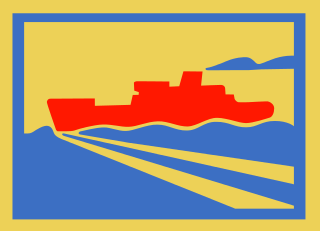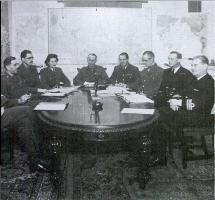
Operation Fortitude was a military deception operation by the Allied nations as part of Operation Bodyguard, an overall deception strategy during the buildup to the 1944 Normandy landings. Fortitude was divided into two subplans, North and South, and had the aim of misleading the German High Command as to the location of the invasion.

Operation Bodyguard was the code name for a World War II deception strategy employed by the Allied states before the 1944 invasion of northwest Europe. Bodyguard set out an overall stratagem for misleading the Oberkommando der Wehrmacht as to the time and place of the invasion. Planning for Bodyguard was started in 1943 by the London Controlling Section, a department of the war cabinet. They produced a draft strategy, referred to as Plan Jael, which was presented to leaders at the Tehran Conference in late November and, despite skepticism due to the failure of earlier deception strategy, approved on 6 December 1943.

The Commandos, also known as the British Commandos, were formed during the Second World War in June 1940, following a request from Winston Churchill, for special forces that could carry out raids against German-occupied Europe. Initially drawn from within the British Army from soldiers who volunteered for the Special Service Brigade, the Commandos' ranks would eventually be filled by members of all branches of the British Armed Forces and a number of foreign volunteers from German-occupied countries. By the end of the war 25,000 men had passed through the Commando course at Achnacarry. This total includes not only the British volunteers, but volunteers from Greece, France, Belgium, Netherlands, Canada, Norway and Poland. The United States Army Rangers and US Marine Corps Raiders, Portuguese Fuzileiros Portuguese Marine Corps were modelled on the Commandos.

Operation Ironside was a Second World War military deception undertaken by the Allies in 1944. It formed part of Operation Bodyguard, a broad strategic deception plan instigated by the Allies throughout the year to help cover the June 1944 invasion of Normandy. Ironside supported the overall deception by suggesting to the Germans that the Allies would subsequently land along the Bay of Biscay. It complemented efforts to deceive the Germans into believing that the Allies would also land in southern France at this time. Bordeaux was an important port for the German war effort and had already been a target of commando raids two years earlier. Ironside intended to play on German fears of an invasion in the region, with the aim of tying down defensive forces following Operation Overlord in June 1944.

The 80th Infantry (Reserve) Division was an infantry division of the British Army formed at the beginning of 1943, during the Second World War. For the twenty months that the division existed, it was a training formation. It was made responsible for providing final tactical and field training to soldiers who had already passed their initial training. After five additional weeks of training, the soldiers would be posted to fighting formations overseas. Notably, the division was used as a source of reinforcements for the 21st Army Group, which was fighting in Normandy. After all available troops left the United Kingdom for France, the division was disbanded.

The London Controlling Section (LCS) was a British secret department established in September 1941, under Oliver Stanley, with a mandate to coordinate Allied strategic military deception during World War II. The LCS was formed within the Joint Planning Staff at the offices of the War Cabinet, which was presided over by Winston Churchill as Prime Minister.

Brigadier Dudley Wrangel Clarke, was an officer in the British Army, known as a pioneer of military deception operations during the Second World War. His ideas for combining fictional orders of battle, visual deception and double agents helped define Allied deception strategy during the war, for which he has been referred to as "the greatest British deceiver of WW2". Clarke was also instrumental in the founding of three famous military units, namely the British Commandos, the Special Air Service, and the naming of the US Rangers.
Operation Cockade was a series of deception operations designed to alleviate German pressure on Allied operations in Sicily and on the Soviets on the Eastern Front by feinting various attacks into Western Europe during World War II. The Allies hoped to use Cockade to force the Luftwaffe into a massive air battle with the Royal Air Force and U.S. Eighth Air Force to give the Allies air superiority over Western Europe. Cockade involved three deception operations: Operation Starkey, Operation Wadham, and Operation Tindall. Operation Starkey was set to occur in early September, Operation Tindall in mid-September, and Operation Wadham in late September 1943.
Operation Hardboiled was a Second World War military deception. Undertaken by the Allies in 1942, it was the first attempt at deception by the London Controlling Section (LCS) and was designed to convince the Axis powers that the Allies would soon invade German-occupied Norway. The LCS had recently been established to plan deception across all theatres, but had struggled for support from the unenthusiastic military establishment. The LCS had little guidance in strategic deception, an activity pioneered by Dudley Clarke the previous year, and was unaware of the extensive double agent system controlled by MI5. As a result, Hardboiled was planned as a real operation rather than a fictional one. Clarke had already found this approach to be wasteful in time and resources, preferring to present a "story" using agents and wireless traffic.

No. 10 (Inter-Allied) Commando was a commando unit of the British Army during the Second World War, recruited largely from non-British personnel from German-occupied Europe. This unit was used to help co-ordinate attacks with other Allied forces.
No. 2 Commando was a battalion-sized British Commando unit of the British Army during the Second World War. The first No.2 Commando was formed on 22 June 1940 for a parachuting role at Cambrai Barracks, Perham Down, near Tidworth, Hants. The unit at the time consisted of four troops: 'A', 'B', 'C' and 'D'. Eventually 11 troops were raised. On 21 November, it was re-designated as the 11th Special Air Service (SAS) Battalion and eventually re-designated 1st Parachute Battalion. After their re-designation as the 11th SAS Battalion, a second No. 2 Commando was formed. This No. 2 Commando was the leading commando unit in the St Nazaire Raid and suffered heavy casualties. Those who made it back from St Nazaire rejoined the few who had not gone on the raid, and the commando was reinforced by the first intake of volunteers from the new Commando Basic Training Centre at Achnacarry. No. 2 Commando then went on to serve in the Mediterranean, Sicily, Yugoslavia, and Albania, before being disbanded in 1946.
No. 14 (Arctic) Commando sometimes also called the Special Commando Boating Group, was a 60-man Commando unit of the British Army during the Second World War. The commando was formed in 1942 for service in the Arctic and was disbanded in 1943.
Operation Hardtack was the name of a series of British Commando raids during the Second World War. The operation was conducted by No. 10 (Inter-Allied) Commando, No. 12 Commando and the Special Boat Service, and took place on the Channel Islands and the northern coast of France in December 1943. Most of the raids consisted of ten men of various ranks, carried by Motor Torpedo Boats and dories, except for one operation, which was an airborne landing. The raids were ended by order of Major General Robert Laycock because they caused the enemy to bring reinforcements, which could have been detrimental to the Allies' strategy.
Ops (B) was an Allied military deception planning department, based in the United Kingdom, during the Second World War. It was set up under Colonel Jervis-Read in April 1943 as a department of Chief of Staff to the Supreme Allied Commander (COSSAC), an operational planning department with a focus on western Europe. That year, Allied high command had decided that the main Allied thrust would be in southern Europe, and Ops (B) was tasked with tying down German forces on the west coast in general, and drawing out the Luftwaffe in particular.

Colonel John Henry "Johnny" Bevan was a British Army officer who, during the Second World War, made an important contribution to military deception, culminating in Operation Bodyguard, the plan to conceal the D-Day landings in Normandy. In civilian life he was a respected stockbroker in his father's firm.

Operation Royal Flush was a military deception employed by the Allied Nations during the Second World War as part of the strategic deception Operation Bodyguard. Royal Flush was a political deception that expanded on the efforts of another Bodyguard deception, Operation Graffham, by emphasising the threat to Norway. It also lent support to parts of Operation Zeppelin via subtle diplomatic overtures to Spain and Turkey.

Operation Ferdinand was a military deception employed by the Allies during the Second World War. It formed part of Operation Bodyguard, a major strategic deception intended to misdirect and confuse German high command about Allied invasion plans during 1944. Ferdinand consisted of strategic and tactical deceptions intended to draw attention away from the Operation Dragoon landing areas in southern France by threatening an invasion of Genoa in Italy. Planned by Eugene Sweeney in June and July 1944 and operated until early September, it has been described as "quite the most successful of 'A' Force's strategic deceptions". It helped the Allies achieve complete tactical surprise in their landings and pinned down German troops in the Genoa region until late July.







